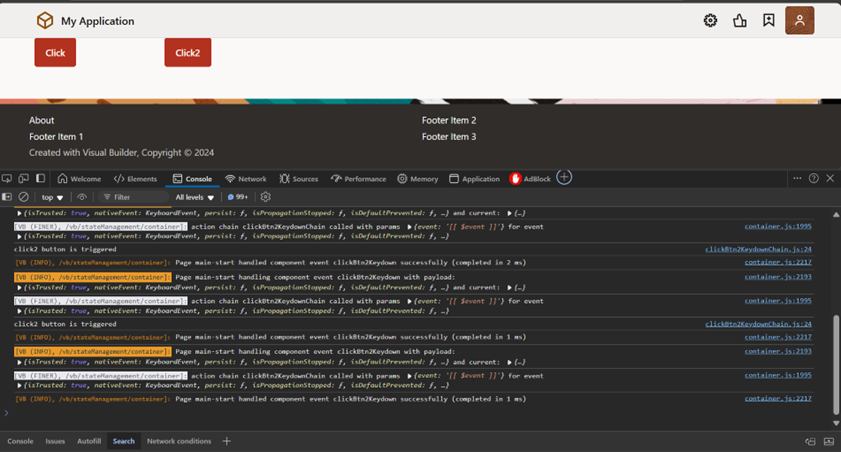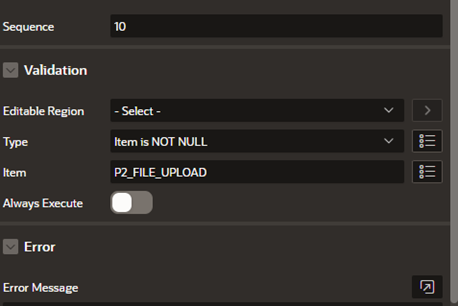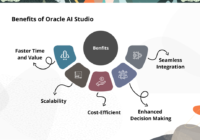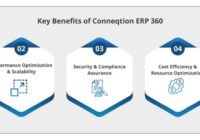Oracle offers multiple low-code and enterprise-grade development platforms, including Oracle Application Development Framework (ADF), Visual Builder Cloud Service (VBCS), and Oracle APEX—each catering to different use cases and business needs.
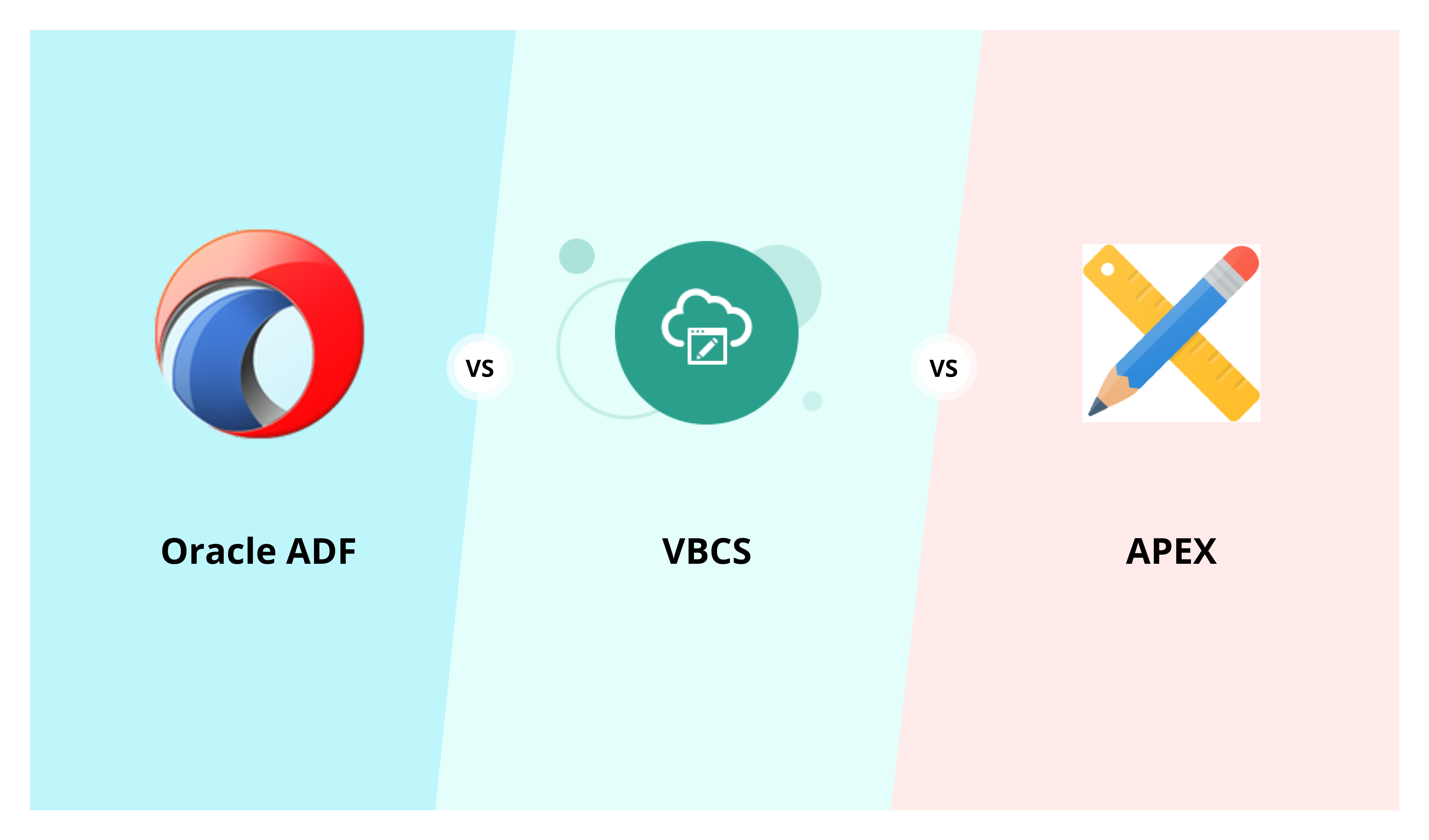
This blog provides a detailed comparison of these three platforms, highlighting their key features, strengths, and ideal use cases. Whether you’re looking for a robust enterprise application framework, a modern cloud-based development tool, or a lightweight yet powerful low-code platform, this guide will help you make an informed decision. So, let’s begin.
1. Feature Comparison
Feature | Oracle ADF | Oracle VBCS | Oracle APEX |
| Purpose | Enterprise-grade, Java-based app development. | Low-code, cloud-based web & mobile apps. | Enterprise grade low-code, database-driven apps, highly secure and scalable. |
| Technology | Java EE, JSF, ADF Faces, WebLogic. | JavaScript, Oracle JET, REST APIs. | PL/SQL, SQL, Oracle Database, minimal knowledge of JavaScript is valuable. |
| Hosting | On-premises & Oracle Cloud | Oracle Cloud (OCI) | Oracle Cloud / On-premises and within 3rd party Cloud environments like AWS & Azure (DB needs to be Oracle), however APEX on OCI is the most recommended and widely used. |
| Customization | Highly customizable (requires Java expertise). | Drag-and-drop UI, JavaScript-based. | Declarative, optimized for DB apps, easy to Customize. |
| Integration | Best for integrating with Oracle Fusion, SOA, middleware. | Seamless with Oracle Fusion & SaaS apps. | Best suited for Oracle Database. Additional configurations for integration with EBS and extend Oracle Fusion SaaS with custom PaaS. |
| Development Speed | Slower due to Java complexity. | Faster UI-based development. | Fastest for database-driven apps with ready to use UI themes and much less code. |
| Mobile Application Development | Oracle ADF Mobile helps enable applications for iOS and Android. | No native mobile code required. VBCS applications can be designed to be responsive and deployed as PWAs (Progressive Web App). | No native mobile code required. Apps built with the Universal theme are mobile friendly and auto responsive with a support creating PWAs (Progressive Web App), as icon for which can be added to your mobile device’s home screen. |
| Learning Curve | High | Medium | Low |
| AI-Assisted development | Oracle code-assist can be used via a plugin in your IDE. (IntelliJ/Visual Studio). | Not widely used. | APEX Assistant – adds AI chat capability to APEX code editors to assist developers writing SQL queries and debugging code. Built in the platform since APEX 24.1. Needs a one-time configuration of an AI service. |
| Deployment Options | Deployed as EAR files using Oracle Enterprise Manager, JDeveloper or WebLogic Server Admin Console. | Flexibility in deployment options based on organizational needs, can be deployed on OCI and on-premises. | APEX applications can be deployed in one click, with artifacts packaged in a single zip file. |
| Best Use Case | Large-scale enterprise apps requiring Java. | Cloud-based UI-driven applications. Seamless integration with Fusion SaaS. | Enterprise grade apps for various IT functions in organizations that need forms, workflows, visual dashboards, better Reporting needs, notifications, an interface to AI and more and integrate with Fusion SaaS via REST/SOAP. |
2. Cost Comparison: Oracle ADF vs VBCS vs APEX
When evaluating Oracle ADF, VBCS, and APEX, cost is a crucial factor that includes licensing, infrastructure, development, and maintenance expenses.
Cost Factor | Oracle ADF | Oracle VBCS | Oracle APEX |
| Licensing | Requires WebLogic Suite & Middleware (High Cost) | Subscription-based (Oracle Cloud pricing varies) | Free with Oracle DB (No additional cost) |
| Infrastructure | Requires WebLogic Server & Oracle DB (On-prem/Cloud) | Runs on Oracle Cloud (PaaS) – Pay for compute/storage | Runs on Oracle DB (On-prem, OCI, AWS, Azure) |
| Development Cost | High – Requires skilled Java developers | Moderate – Low-code with UI-based development | Low – PL/SQL-based, rapid development |
| Maintenance Cost | High – Requires ongoing patching, WebLogic management | Moderate – Oracle manages most updates | Low – Minimal maintenance needed |
| Total Cost of Ownership (TCO) | High – Best for large enterprises with high customization needs | Medium – Cloud-based, flexible cost structure | Low – Cost-effective for database-driven solutions |
Choosing the right platform depends on your business requirements, budget, and long-term strategy.
3. Pros and Cons
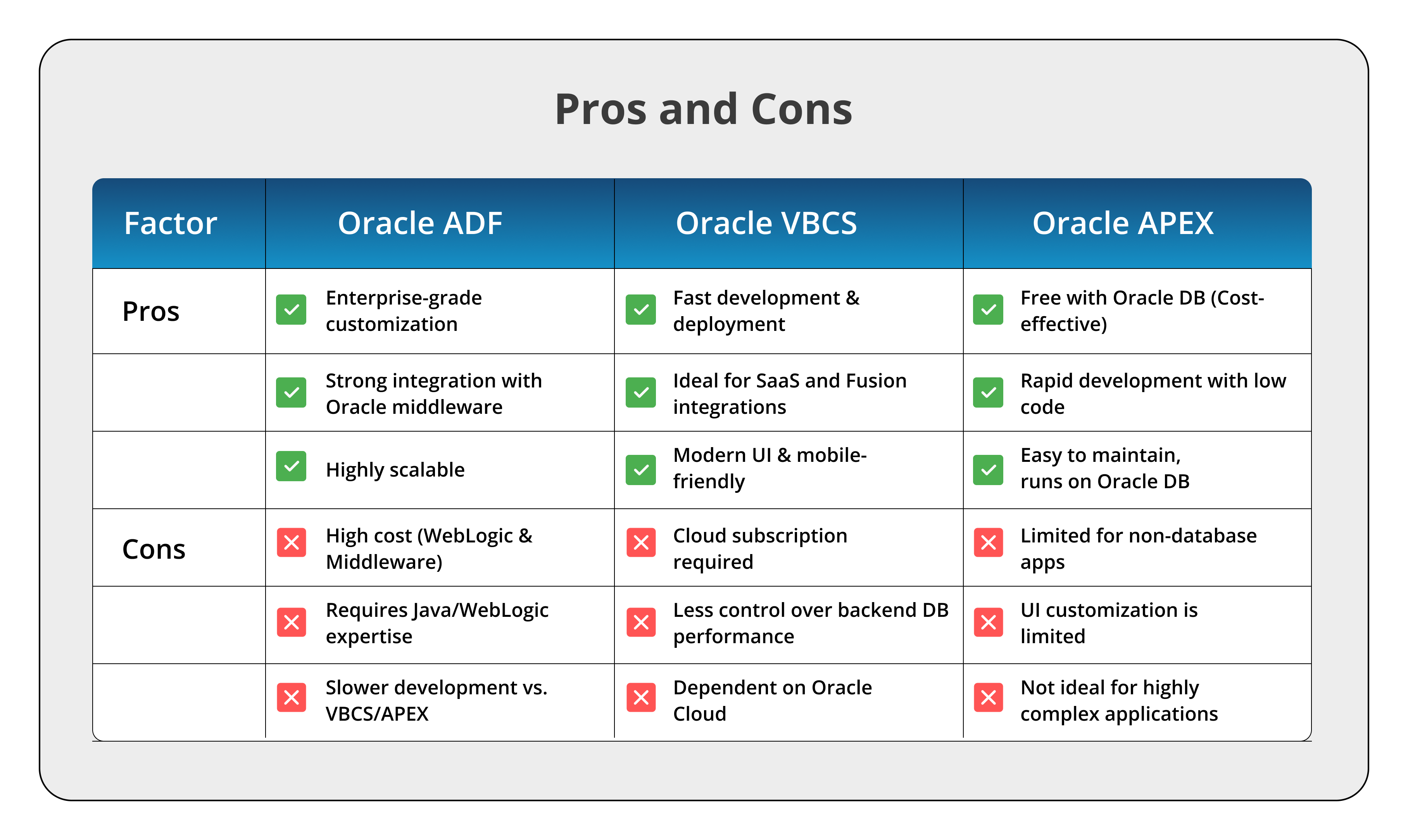
4. Which One Should You Choose?
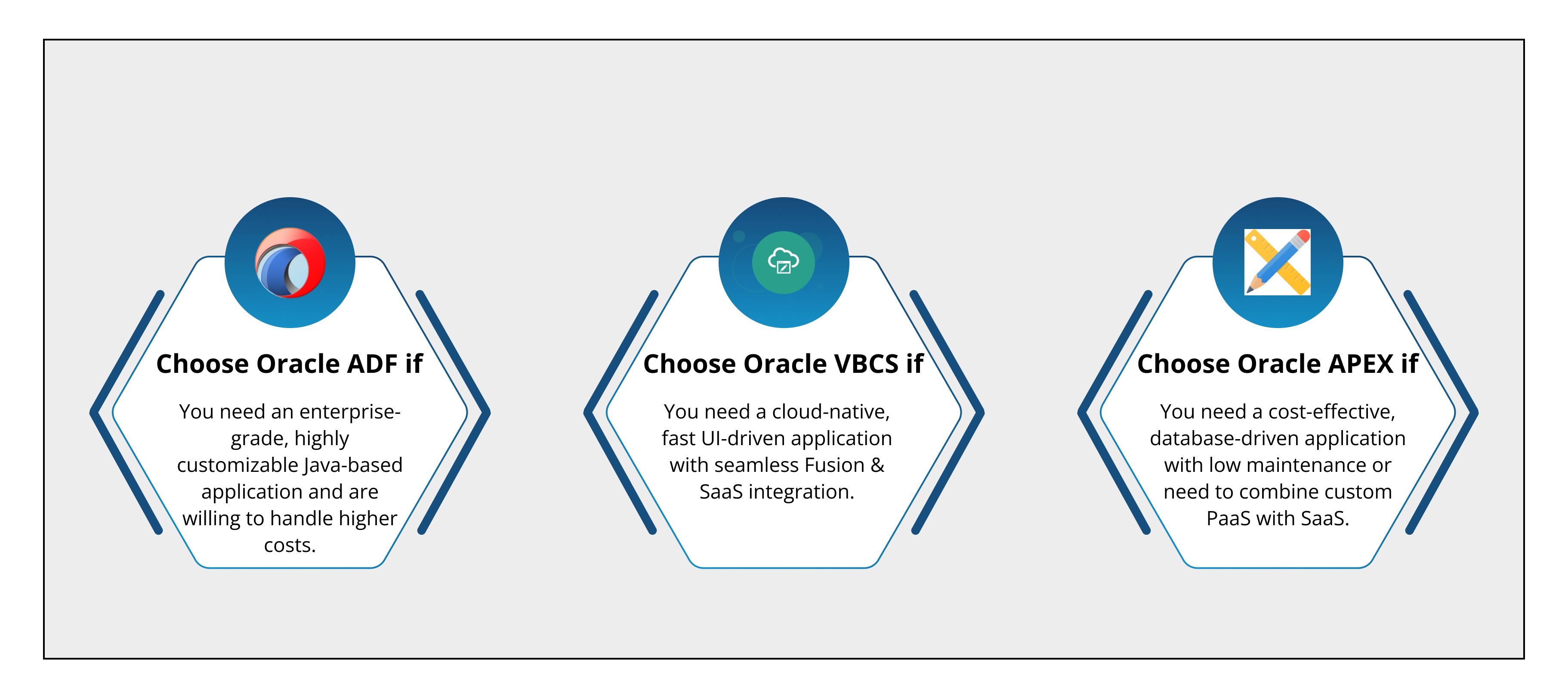
5. Cost Estimation
Oracle ADF
- Infrastructure: Requires Oracle WebLogic Server & Oracle Database (OCI-hosted).
- Cost Estimation:
- 1.WebLogic Server: ($602 per OCPU/month).
- 2.Oracle Database: Autonomous Transaction Processing (~$360 per month for 1 OCPU, 1TB storage).
- 3.Total Estimated Monthly Cost: ~$962 (Additional costs may apply based on configurations & usage).
- 1.
Oracle VBCS
- Infrastructure: Cloud-native, hosted on OCI (abstracts infrastructure management).
- Cost Estimation:
- 1.VBCS Subscription: User-based or per-application pricing (varies based on scale).
- 2.Total Estimated Monthly Cost: Varies (~Hundreds of dollars per month for small-scale apps).
- 1.
Oracle APEX
- Infrastructure: Runs within Oracle Database (OCI or On-Premises).
- Cost Estimation:
- 1.APEX Service: ~$240 per month for 1 OCPU, 1TB storage.
- 2.Oracle Autonomous Database: ~$119 per month
- 3.Total Estimated Monthly Cost: ~$360.
- 1.
6. Cost Optimization Strategies
Tools to Optimize Cost:
- Oracle Cloud Cost Estimator: Predict and manage OCI expenses.
- OCI Auto Scaling: Dynamically scales resources based on demand.
- Oracle Cloud Advisor: Provides recommendations for cost savings.
- Oracle Application Performance Monitoring (APM): Monitors performance to optimize resource usage.
- Git & DevOps Tools: Automate CI/CD pipelines to reduce manual deployment effort.
Process Optimization:
- Use APEX for DB-driven apps → Avoid unnecessary licensing costs of ADF.
- Leverage VBCS for UI-driven cloud apps → Reduce development time & infra costs.
- Optimize OCI Compute Instances → Choose cost-effective shapes instead of overprovisioning.
- Use Autonomous Database → Reduces DBA effort and infrastructure costs.
- Leverage API Gateways & Caching → Minimize unnecessary database calls to cut costs.
- Consider Serverless Computing (OCI Functions) → Pay only for execution time instead of provisioning full servers.
7. Additional Considerations
- Usage Patterns: 100 transactions/day is low, but scalability, peak usage, and data transfer costs should be considered.
- Licensing Compliance: Ensure adherence to Oracle’s licensing policies for ADF/WebLogic.
- Support & Maintenance: APEX and VBCS reduce overhead due to their managed-service nature.
For a detailed consultation, Oracle’s Cloud Cost Estimator can provide an exact quote based on real-world usage.
Conclusion
Oracle ADF, VBCS, and APEX each offer unique advantages, catering to different business needs and development approaches. Oracle ADF is ideal for large-scale enterprise applications with complex data models, VBCS is perfect for cloud-native and modern web applications, and Oracle APEX stands out as a powerful low-code solution for rapid application development.
The right choice depends on factors such as project complexity, deployment preferences, and development expertise. By understanding their capabilities, you can align your technology strategy with your business goals effectively.
Need expert guidance on choosing the best Oracle development platform for your business? Contact Conneqtion Group today and let our specialists help you accelerate your digital transformation!


